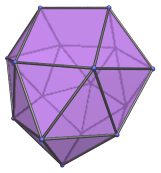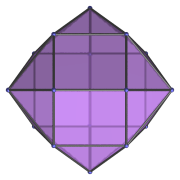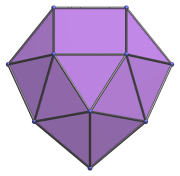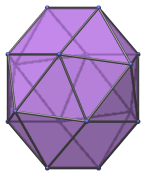The Disphenocingulum
The disphenocingulum is the 90th Johnson solid (J90). Its surface consists of 24 faces (20 equilateral triangles and 4 squares), 38 edges, and 16 vertices.

The disphenocingulum is one of the special Johnson solids at the end of
Norman Johnson's list that are not directly derived from the
uniform polyhedra by cut-and-paste operations. As
Norman Johnson explains, a lune is a square with two opposite edges
attached to equilateral triangles, and a spheno (Latin for
wedge) complex is two lunes joined together to form a wedge-like
structure. The prefix di- means two
, and cingulum
(Latin for belt) refers to a belt of 12 triangles. Thus,
di-spheno-cingulum refers to taking two spheno complexes and joining
them to either side of the belt of 12 triangles. It so happens that if the
spheno complexes are rotated 90° with respect to each other, the result can be
closed up into a polyhedron with regular faces.
Projections
Here are some views of the disphenocingulum from various angles:
| Projection | Description |
|---|---|
 |
Top view. |
 |
Front view. |
 |
45° side view. |
Coordinates
The Cartesian coordinates of the disphenocingulum, centered on the origin with edge length 2, are:
- (±1, 0, A)
- (±1, ±B, C)
- (±D, 0, E)
- (0, ±D, −E)
- (±B, ±1, −C)
- (0, ±1, −A)
where B is the root of the following polynomial between 1.5 and 1.6:
B12 − 4B11 − 26B10 + 116B9 + 97B8 − 824B7 + 312B6 + 2176B5 − 2024B4 − 1888B3 + 2688B2 − 192B − 368 = 0
and:
| C | = | √((1+2B−B2) / 2) |
| A | = | C + √(4−B2) |
| E | = | (A2−B2−C2) / (2√(4−B2)) |
| D | = | 1 + √(4−(A−E)2) |
Numerically, A, B, C, D, and E have the approximate values:
- A = 2.208875884159868
- B = 1.534262227966923
- C = 0.925895207830730
- D = 2.252966294157959
- E = 0.650005951899941




